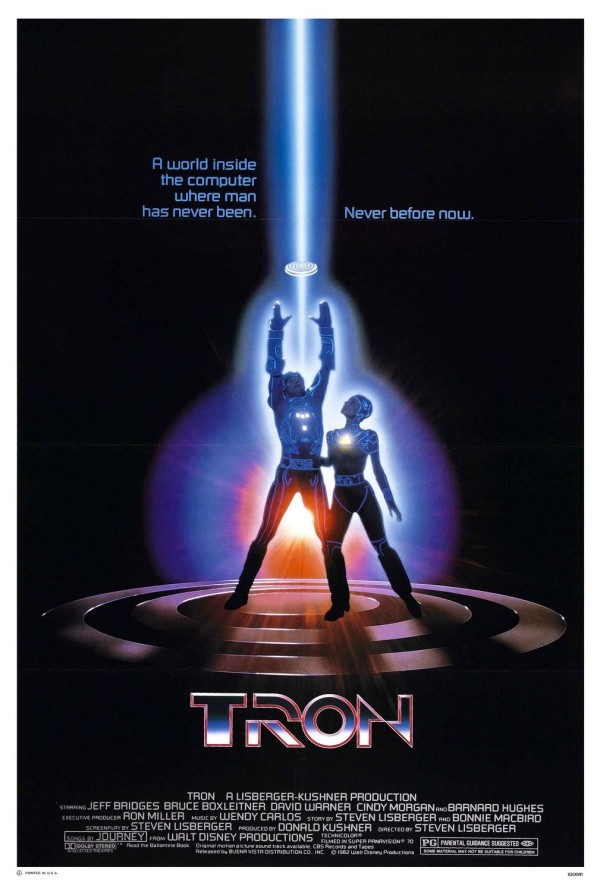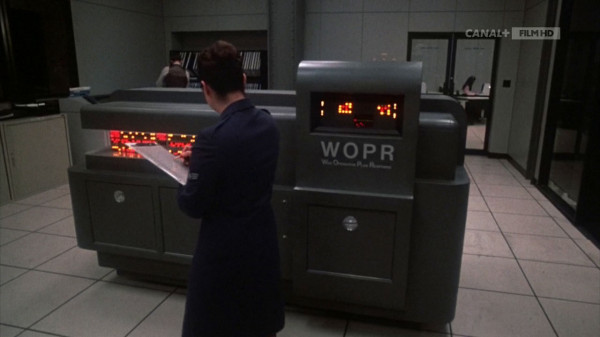Before William Gibson and the eventual cinematization of his ideas, The Matrix, but after Shockwave Rider and The Moon is a Harsh Mistress, Tron captured the imagination of the public with a movie that adapted the Star Wars series to take place inside a computer. More of a culmination of ideas and a reduction of them to a tangible form than an entirely new idea on its own, Tron defined the cyberpunk wave of science fiction by laying out the basic ingredients of all of its future drama. The result is a visually compelling movie that compares to Metropolis and Blade Runner for its graceful but imposing artistic representation of its topic.
Set in approximately the same time in which it was filmed, this movie follows the path of a hacker trying to find proof that he wrote a massively successful video game which has been stolen by a 1980s style evil large corporate entity. The only glitch is that the secret exists only within the massive mainframe computer that, like the AIs in The Moon is a Harsh Mistress and Neuromancer, assists that corporate entity… and may partially control it. The mainframe is controlled by a program that resembles the early worms that conquered much of the internet in that it absorbs smaller programs and uses them, zombie-like, as its agents, slowly gaining power as it absorbs more code. In the process of trying to gain entry to the machine, the hacker is captured and digitized by it. Now he must break through its security to escape.
At this point, it becomes necessary to point out that there are two movies in Tron. One is a science fiction story that summarizes much of the thinking about virtual reality from the previous decade, and another is a movie that — look at the logo on the cover — applies the Disney-style Hollywood treatment to make a story dramatic and yet accessible. The two do not completely integrate and the science fiction dominates most of the first two-thirds of the movie, at which point its storyline becomes obvious and Hollywood takes over for the touchdown. The great strength of this movie is that it made visualizations of computer concepts in the way that has always distinguished Disney productions; its most poignant image, perhaps borrowed a little bit from Thomas Pynchon, is of the neon-light modern city and how it resembles a visual representation of computer programs.
Where Pynchon compared the lighted city skyline to circuit boards, Tron makes programs into lighted cityscapes that resemble circuit boards, but represent the interaction of programs, users and data. Gibson took this image further and removed the city from it, making it merely a cool-looking abstract space that overlapped with the city but did not directly represent it. Much as both Pynchon and Gibson were influenced by W.S. Burroughs, in this story the computer realm resembles Interzone, or a place where the symbolic becomes real and yet the real can be manipulated by symbols. If you need that dumbed down to a stupefactive level, go see The Matrix, which is 5,000 times more Hollywood-Disney than Tron and is designed to neutralize the power of these concepts.
In Burroughs, Nietzsche comes to life (from On Truth and Lies in a Non-Moral Sense): words manipulate like program code written right into our brains, and the only solution is to decode the message and compare it to reality, at which point one can escape. The Matrix is like the French Revolution writ large onto the screen, in that some simplistic evil corporation keeps everyone in a state of illusion — much like movies and TV including The Matrix do — by creating a false reality. When they wake up, recognizing that the reality is false is enough, and suddenly everyone comes together and sings kumbaya and celebrates the fact that they are all free now. Sound familiar? Yes, it is the standard movie plot of everything from Revenge of the Nerds to Three Days of the Condor. It also compares somewhat to other movies from the same genre of mood as this one and the same time period, such as Blade Runner and Wargames, each of which involves a man fighting technology for liberation theme.
The interesting science fiction movie within Tron starts at the moment that man is digitized into the machine. Most cyberspace dramas focus on the virtual becoming real, but in this case the real becomes virtual and must find a way to escape from the machine. The movie misses out on what may be the real story, which is how changing data in a machine can change real life, by putting the protagonist Flynn (Jeff Bridges, a spiral cut ham) into the machine. If one bit in your record at the DMV or credit bureau becomes changed, your life will take a radically different turn. By focusing on the escape itself instead, Tron manages to spin itself into an interesting tale where a man must play several video games and win before he can break out into the machine itself, circumvent its security measures and then disable the rogue program that controls it.
This “escape” theme works well but disconnects real from virtual worlds, which makes it difficult to have any central narrative except the liberation of the machine itself, which conveniently also liberates the information Flynn needs. For the first two-thirds of the movie, Tron plays with its ability to visualize video games as if the participant were inside of them, and works out a few basic computer concepts in visual form as well, which was necessary to prepare the mainstream audience to understand the weird gadgets that were only just beginning to penetrate homes. When the Hollywoodization takes over, the final third of the movie becomes more like Star Wars and your typical 1980s adventure movie, which causes a somewhat incoherent sequence to segue into a happy ending.
As a movie from its time period, Tron holds up brilliantly over thirty years later. The graphics still look believable and the basic metaphor of man in machine as a program fighting for survival against assimilation strikes a chord with our own struggle to avoid having our brains taken over by the endless memes, advertising, political promises, slogans and trends that keep our modern world under control. While the ending is both slightly confused, fairly derivative and moronically basic in the way only Hollywood can do, it does not detract from an otherwise intriguing and imaginative film that may be one of the more impressive works of quasi-apocalyptic cinema from that era.
4 CommentsTags: cyberpunk, cyberspace, hacking, jeff bridges, tron




